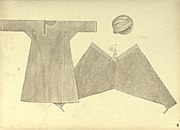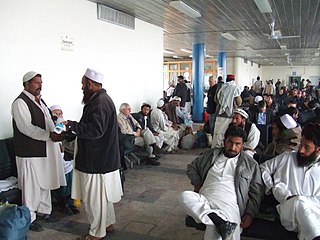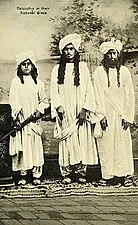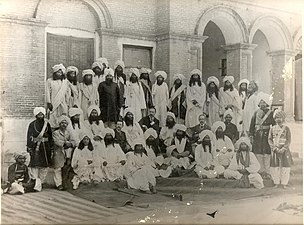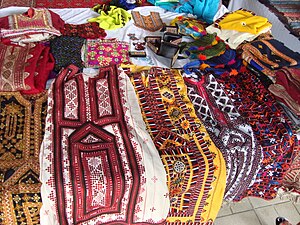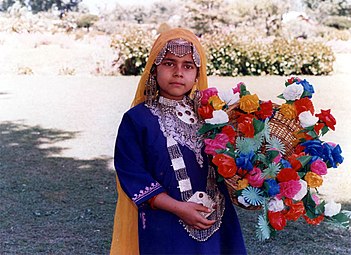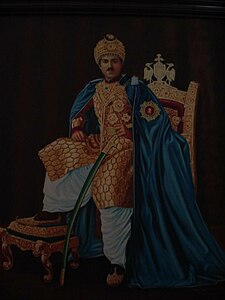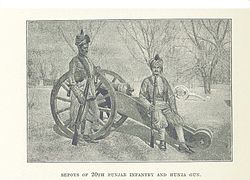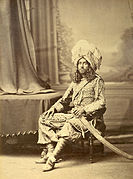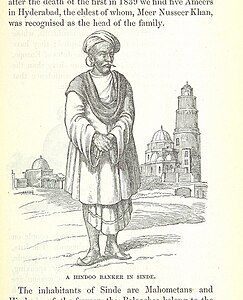Ŝalvarĉemizo



La ŝalvarĉemizo estas tradicia duparta vestaĵo portata de inoj kaj en kelkaj regionoj de viroj, en suda kaj centra Azio.
La ŝalvaroj estas pantalonoj kiu estas tre larĝaj ĉe la talio sed kiu mallarĝigas sin ĉe la fundo. Ili estas ligataj per ŝnuro aŭ elasto, kiu plisas ilin ĉirkaŭ la talio.[2] La pantalonoj povas esti larĝaj, aŭ en aliaj kazoj ili povas esti tondataj tre mallarĝaj, laŭ la persona gusto. La ŝalvaroj estis tradicie portitaj en vasta regiono kiu inkluzivas orientan Eŭropon, okcidentan Azion, centran Azion kaj Sudan Azion.[3][4][5][6] La ĉemizo (angle kameez) estas longa kaj kun formo de tuniko.[7] La flanka parto estas malfermita sub la linio de la talio (tiu malfermo estas konata kiel chāk), kiu donas al la vestanto pli grandan liberecon de movado. La ĉemizo estas kutime tondata rekte kaj plate; kelkaj malnovaj ĉemizoj sekvas malsaman tradician tondon; modernaj ĉemizoj havas manikojn kun stilo inspirata al eŭropaj vestaĵoj. La ĉemizo povas havi eŭropastilan kolon, ĉinan kolon aŭ ĝi povas esti tute senkola; en la lasta kazo, ties desegno kiel ina vesto ofte similas al kurtao. La duparta vesto estas foje konata kiel ŝalvarkurtao, ŝalvar-vestokompleto aŭ panĝaba vestokompleto.[8][9]
Ambaŭ la ŝalvaro kaj tiu speco de ĉemizo ekaperis en suda Azio kun la alveno de la islamanoj ĉe la nordo, dum la 13-a jarcento: unue portita fare de islamaj inoj, ilia uzo pli kaj pli disvastiĝis, kaj ili fariĝis tipa regiona stilo, precipe en la historia regiono de Panĝabio.[9][10][11][12][13][14] La ŝalvarĉemizo estas portita kiel ordinara vesto kaj eĉ taksata kiel nacia vesto en Pakistano.[15][16][17] Ĝi estas ankaŭ ĝenerale portita fare de viroj en Afganio, de inoj kaj kelkaj viroj en la panĝaba regiono de Barato; kvankam ĝi devenas de tiuj regionoj, ĝi estas hodiaŭ adoptata fare de inoj de tuta Barato kaj, pli ĝenerale, de multaj regionoj en suda Azio.[18][19][20]
Kiam inoj havas la ŝalvarĉemizon, en kelkaj regionoj ili kutime portas ankaŭ longan koltukon aŭ ŝalon nomata dupatta ĉirkaŭ siaj kapoj aŭ koloj.[21][22] En suda Azio, la dupatta estas ankaŭ uzata kiel formo de modesteco — fakte, kvankam ĝi estas farita per altvaloraj materialoj, ĝi efike kaŝas la konturojn kaj liniojn de la korpo super la ŝultroj. Por islamaj inoj, la dupatta estas malpli rigora alternativo por anstataŭi la ĉadoron aŭ la burkon (bv. vidi hiĝabon kaj purdahon); por la sikaj kaj hinduaj inoj, la dupatta estas utila kiam la kapo devas esti kovrita, kiel ekzemple ene de preĝejo aŭ kiam ĉeestas plejaĝuloj.[23] Ĉie en suda Azio, modernaj versioj de la vesto evoluis; la ŝalvaroj estas portataj pli malalte, malsupre ĉe la talio, kaj la ĉemizo havas pli mallongan longecon, kun pli altaj fendoj, pli malalta kola linio kaj kun tonditaj manikoj aŭ entute sen manikoj.[24]
Etimologio kaj historio
[redakti | redakti fonton]-
Tablo 41. Turkio, Sirio, Mezopotamio. Tri malsame tonditaj viraj pantalonoj. [...] Blua ŝnuro kunigas la pantalonon en faldojn ĉe la fundo. (1922) Tilke Coll kaj la Etnologia Muzeo de Berlino.
-
Tablo 85. Afganio. La pantalonoj (larĝaj 460 cm) montritaj en ĉi tiu tablo ne estas la plej ordinaraj en Afganio. Ili estas unuigitaj en faldojn ĉe la talio per silka bando. (1922) El privata kolektado.
La esperanta vorto «ŝalvaro» devenas el la persa lingvo. Laŭ la Oksforda angla Vortaro ties etimologio estas: «< Urdu šalwār, Hindi salvār, < persa šalwār.».
-
Tablo 90. Panĝabio. Vira ĉemio, Kaŝmiro. La malfermaĵo ĉe la kolo havas persastilan formon. Vira pantalono, Kaŝmiro. Larĝa formo. (1922) El la Berlina Etnografia Muzeo.
-
La tripeca ina vesto konsistanta el pantalono, tuniko, kaj kaptuko, ĉ. 1900. El la Indianapola Muzeo pri Arto.
La esperanta duparta vorto «ŝalvarĉemizo» estas internacia vorto kiu devenas de la urdua.[25]
Priskribo
[redakti | redakti fonton]La ŝalvaro estas malstreĉaj pantalonoj similaj al piĵamo. La kruroj estas larĝe ĉe la supro kaj mallarĝa ĉe la maleolo. La ĉemizo estas longa ĉemizo aŭ tuniko, kiun oni ofte inkluzivas okcidenta-stilan kolon; tamen, en kazo de inaj vestaĵoj, la termino estas nun uzata ankaŭ por priskribi kurtaojn kun mandarena kolumo aŭ eĉ tute senkolumaj. La ĉemizo povus esti portita kun eĉ kune kun piĵamo, kaj pro modo kaj pro komforto.
Stiloj
[redakti | redakti fonton]La ĉemizo povas esti kudrita rekte kaj plate, sekvante la formon de litero 'A', aŭ foje fluanta kiel vesto; estas vario de stiloj.[26]
Inter la aliaj stiloj indas mencii: la peŝavaran ŝalvaron, baluĉian ŝalvaron, la sindan ĉorenon kaj la panĝaba ŝalvaron.
Kvankam en malsamaj regionoj de la Hindia subkontinento oni nun portas la vestaĵojn en malsamaj formoj, tiu speco de vestaĵoj estis originale populara sur larĝa skalo nur en Afganio, Ĥajber-Paŝtulando, Baluĉio[27] kaj en Panĝabio.[28][29][30] Tamen, la ŝalvarĉemizo nun fariĝis poste populara trans la tuta Hindia subkontinento.[31]
Malsamaj formoj
[redakti | redakti fonton]
Jen kelkaj de la stiloj de ŝalvarĉemizo.
Anarkali vestokompleto
[redakti | redakti fonton]La ŝalvarĉemizo konata kiel la Anarkali-vestokompleto devenas el la urbo de Lahoro.[32] Ĉi tiu vestokompleto havas sentempan stilon, kaj fariĝis tre populara. Ĝi konsistas el longa supro kaj prezentas maldikan fundon. Ĉi tiu stilo de vestokompleto unuigas la Hindian subkontinenton kun la ina firaq partug (robo kaj ŝalvaro) de nordokcidenta Pakistano kaj Afganio kaj kun la tradiciaj vestaĵoj de kelkaj partoj de centra Azio.[33] Ĝi ankaŭ ligas al la panĝaba regiono, kie la Anarkali-vestokompleto estas simila al la anga kaj al la peshwaz portita en Ĝamuo.[34][35][36]
Afganiaj vestokompletoj
[redakti | redakti fonton]La stiloj de ŝalvarĉemizoj portitaj en Afganio inkluzivas diversajn stilojn de khet partug, perahan tunban kaj Firaq partug portitaj fare de paŝtunoj, taĝikoj kaj hazaroj.[37][38] The shalwar tends to be loose and rests above the ankles.[39]
-
Viro en afgana vestaĵo: «perahan tunban».
-
Afganaj infanoj portantaj tradiciajn vestaĵojn en Kabulo.
-
Viroj portantaj perahan-tunban-on, formo de ŝalvarĉemizo en Kabula flughaveno, en Afganio.
Peŝavara ŝalvara vestokompleto
[redakti | redakti fonton]
La tradicia vesto de Peŝavaro kaj de aliaj partoj de Ĥajber-Paŝtulando, en Pakistano, konsistas el la khalqa, kiu malfermiĝas antaŭe, aŭ el ĉemizo kiu ne malfermiĝasantaŭe kaj la peŝavara ŝalvaro kiu estas tre malstreĉa super la maleoloj.[40][41][42] La peŝavara ŝalvaro povas esti uzita kun nombro de supraj vestoj kaj estas parto de la vestaĵo de Ĥajber-Paŝtulando.
Baluĉaj vestokompletoj
[redakti | redakti fonton]La vestaĵoj de Beluĉio, en Pakistano, inkluzivas la ŝalvarĉemizon; en la vira formo, ĝi konsistas el tre larĝaj kaj longaj ŝalvaroj.[43] using large lengths of cloth.[44] The kameez is also loose,[45] La ĉemizo estas ankaŭ malstreĉa kaj tradicie estas longa, kun longaj manikoj.[46][47]. La Paŝtunoj en norda Beluĉio havas vestojn similaj al la stiloj portita en Afganio.
-
Beluĉa vira ŝalvarĉemizo, Quetta, 1867.
-
Tradiciaj beluĉiaj vestokompletoj.
-
Tribaj maljunaj estroj, aprilo 1896.
-
Tradicia beluĉa vesto.
-
Beluĉa vesto.
-
Beluĉa brodaĵo.
-
Tradiciaj beluĉaj vestoj.
Phiran, poots kaj ŝalvaroj
[redakti | redakti fonton]En Kaŝmiro, la vestaro konsistas el phiran, poots kaj ŝalvaro.[48]
-
Maldekstre kaj dekstre: «phiran» ŝalvaro; centre: panĝaba vestokompleto.
-
«Phiran» el Kaŝmirio.
-
Viro de Srinagaro kun «phiran».
-
Kaŝmira ino en longa tradicia «phiran», 1870.
-
Viro en kaŝmiraj «phiran» kaj «poots», 1875.
Panĝabaj vestokompletoj
[redakti | redakti fonton]La tradicia ŝalvarĉemizo portita en la panĝaba regiono estas tondita malsame al la stiloj portita en Beluĉio kaj Afganio, kaj estas konata kiel «panĝaba vestokompleto» kun la ĉemizo tondata rekte kaj plate. En kampara Panĝabio, la ŝalvaro estas ankoraŭ konata kiel suthan, kiu estas malsama vesto kiu estis populara en antaŭaj jarcentoj. En Britio, britaj-aziaj inoj de la panĝaba regiono de la Hindia subkontinento igis la veston popularega, kaj ĝi atingis la altan modon.[49][50][51] La panĝaba vestokompleto estas populara en aliaj regionoj de la Hindia subkontinento, kiel Mumbajo kaj Sindo.[52][53][54][55] La popularecon de panĝabaj vestokompletoj en Barato dum la 1960-aj jaroj estis kaŭzita de Barataj filmoj kaj kino.[56] Punĝabaj vestokompletoj estas ankaŭ popularaj inter junaj inoj en Bangladeŝo[57] kaj estas precipe populara inter studantinoj en Barato.[58] La vestaĵoj estas ankaŭ popularaj en Afganio,[59] kie ĝi estas konataj kiel «panĝaba [vestmaniero]».[60][61][62]
-
Panĝaba ŝalvarĉemizo.
-
Inoj kun panĝabaj vestokompletoj.
-
Sinjorino Pooja de la panĝaba regiono kun panĝaba vestokompleto.
-
Vira panĝaba ŝalvarĉemizo.
-
Knabinoj alvenas al lernejo. Ĝamuo, ĉ. 1875 - ĉ. 1940
-
Inoj en ornamitaj ŝalvaroj
-
La bandhani vesto de Rohi (Cholistan). Panĝabio, Pakistano.
-
Unua Panĝaba Vikipedia Laborrenkontiĝo: inoj en panĝabaj vestoj.
-
Inoj portantaj tradiciajn vestaĵojn en panĝaba kuirejo, 1899.
-
Studantinoj portantaj Patiala ŝalvarvestokompletojn.
Alia ofta tipo de panĝaba ŝalvarĉemizo estas la Patiala ŝalvaro kiu havas multajn faldojn kaj devenas de la urbo de Patialo. Alia stilo de la panĝaba vestokompleto devenes de la Pothohar-a regiono de Panĝabio, en Pakistano, kaj estas konata kiel Pothohar-a ŝalvaro.[63]
Saraiki ŝalvarvestokompletoj estas panĝabaj vestoj kiu inkluzivas la Bahawalpur-an ŝalvarvestokompleton kaj la Multana salvarvestokompleton.
La Bahavalpura ŝalvaro [64] devenas de la Bahavalpura regiono de Panĝabio, en Pakistano. La Bahavalpura ŝalvaro estas tre larĝa,[65] kun multaj egaj faldoj.[66] La materialo tradicie uzita por la Bahavalpura ŝalvaro kaj suthan estas konata kiel Sufi.[67] The other name for these types of mixed cloth is shuja khani.[68] The Bahawalpuri shalwar is worn with the Bahawalpur style kameez, the Punjabi kurta or chola.[69]
-
Nawab Muhammad of Bahavalpuro (1868-1900) portante malstreĉan Bahavalpuran ŝalvaron.
-
Princo Suba Sadiq Abbasi, Bahavalpuro.
-
Bahavalpura ĉemizo.
-
Navab Sadik Ĥan la 5-a (mortita en 1966)[70] en la Bahavalpura ŝalvaro.
La Multana ŝalvaro, ankaŭ konata kiel «ghaire wali» aŭ kiel «Saraiki ghaire wali» devenas de la Multana areo de la panĝaba regiono. La stilo estas simila al la sinda kancha ŝalvaro ĉar ambaŭ estas derivaĵoj de la pantaluna ŝalvaro portita en Irako[71] kaj adoptita en ĉi tiuj lokoj dum la 7-a jarcento n.e.. La Multana ŝalvaro estas tre larĝa kaj havas faldojn kiel la panĝaba suthan.[72][73][74][75][76] La supraj vestoj inkluzivas la panĝaba ĉemizo kaj la chola de la panĝaba regiono.[77]
Pli malnova speco de ŝalvarĉemizo de la panĝaba regiono estas la panĝaba suthan kaj kurtao.[78] La panĝaba suthan estas loka speco de la antikva svasthana streĉaj pantalonoj kiu estis uzitaj en la panĝaba regiono ekde antikvaj epokoj, kaj estis portitaj kune kun tuniko nomata varbana,[79][80] and were worn with the tunic called varbana[81] kiu estis streĉa vesto.
-
19-a jarcento panĝaba suthan vestokompleto portita fare de la dekstra ino.
-
Inoj en panĝaba suthan,1890.
-
Inoj (dekstre) kun malstreĉaj panĝaba suthan.
-
Panĝaba ino en panĝaba suthan kaj mallonga kurtao, 1874.
-
Antikva svasthana kaj varbana vestaĵoj portita dum la Gupta imperio, fundamentaj en la vestaro de Panĝabio.
-
Viro kun mallarĝa panĝaba suthan, 1893.
-
Navab Muhamad Bahaval Ĥan Abasi la 5-a Bahadur (1883-1907) de la Bahavalpura Ŝtato, kun suthan.
Sinda vestmaniero
[redakti | redakti fonton]La tradicia Sinda ŝalvaro,[82] ankaŭ konata kiel kancha,[83] konsistas el larĝaj pantalunoj[84] kiuj estas larĝaj malsupre de la kruroj kaj eĉ larĝaj ĉe la maleoloj.[83]
-
Viro en Sinda tradicia Kancha-ŝalvaro.
-
Knabino de Karaĉio, Sindo, kun ŝalvaro kaj bluzo. Ĉ. 1870. Orienta kaj Hindia Oficeja Kolekto, Brita Biblioteko.
-
Viro kun longa sinda angerkho (1845).
Aliaj stiloj de ŝalvarĉemizo estas inaj Sindaj suthan kaj cholo kaj vira Sinda suthan kaj angelo.[85]
Referencoj
[redakti | redakti fonton]- ↑ (2013) Derailing Democracy in Afghanistan: Elections in an Unstable Political Landscape (angle). Columbia University Press. ISBN 978-0-231-53574-8. “Ekzemple, multaj politikistoj portas vestokompletojn estante en Kabulo, sed ŝanĝiĝos al ŝalvarĉemizo, tradicia kostumo kun larĝa pantalono kaj tuniko, kiam ili revenas al siaj hejmprovincoj por emfazi siajn lokajn ligojn.”.
- ↑ Stevenson, Angus. (2011) Concise Oxford English Dictionary: Book & CD-ROM Set (angle). Oxford University Press. ISBN 978-0-19-960110-3. “Salwar/Shalwar: paro de malpeza, loza, plisita pantalono, kutime mallarĝa ĉirkaŭ la maleoloj, portita fare de inoj de Sudazio tipe kun kameez (la du kune estante salwar kameez [ŝalvarĉemizo]). Devena de la persa kaj la urdua šalwār.”.
- ↑ Gavrilova, Raĭna. (1999) Bulgarian Urban Culture in the Eighteenth and Nineteenth Centuries (angle). Susquehanna University Press. ISBN 978-1-57591-015-4.
- ↑ Cole, Jeffrey E.. (2011) Ethnic Groups of Europe: An Encyclopedia: An Encyclopedia (angle). ABC-CLIO. ISBN 978-1-59884-303-3.
- ↑ Scarce, Jennifer M.. (2014) Women's Costume of the Near and Middle East (angle). Routledge. ISBN 978-1-136-78385-2.
- ↑ Gole, Nilufer. (1996) The Forbidden Modern: Civilization and Veiling (angle). University of Michigan Press. ISBN 0-472-06630-7.
- ↑ Stevenson, Angus. (2011) Concise Oxford English Dictionary: Book & CD-ROM Set (angle). Oxford University Press. ISBN 978-0-19-960110-3. “Kameez: longa tuniko portata fare de multaj homoj de Sudazio, tipe kun salwar aŭ churidar-oj. Deveno: de la araba qamīṣ, eble de malfrua latina camisia (vidu ĉemizon)”.
- ↑ Shukla, Pravina. (2015) The Grace of Four Moons: Dress, Adornment, and the Art of the Body in Modern India (angle). Indiana University Press, p. 75. ISBN 978-0-253-02121-2. “Oni povas aĉeti tutan tripecan salwar-kostumon, aŭ dupecan kostumon kiu konsistas el aŭ preta kurta aŭ kurta ŝtofpeco, ĉiu kun kongrua dupatta. Kune kun ĉi tiuj, oni devas meti la ŝalvarojn pantalonojn kudritaj el ŝtofo, kiun oni aĉetas aparte. Tria opcio estus aĉeti dupecan ensemblon, konsistantan el la supro kaj pantalono, lasante al oni la taskon aĉeti taŭgan dupatta-n, aŭ uzi tiun, kiun oni jam posedas, aŭ aĉeti strion da ŝtofo kaj meti ĝin, tinkturita laŭ via deziro. La fina rezulto estos ĉiam tripeca ensemblo, sed kliento povas komenci per unu peco (nur la kurta) aŭ du pecoj (kurta kaj pantalono, aŭ kurta kaj dupatta), kaj ekzercu ŝian kreemon kaj modon por fini kun la vestokompleto salwar kurta.”.
- ↑ 9,0 9,1 Mooney, Nicola. (2011) Rural Nostalgias and Transnational Dreams: Identity and Modernity Among Jat Sikhs (angle). University of Toronto Press. ISBN 978-0-8020-9257-1. “La ŝalvarĉemizo estas formo de robo kiu estas vaste adoptita en Panĝabio kaj nun estas konata en la angla kiel la Punjabi suit [panĝaba vestokompleto]; J. P. S. Uberoi sugestas ke la ŝalvarĉemizo estas afgana importo al Panĝabio (1998, persona komunikado). Panĝabaj formoj de robo estas tial konstrukcioj aŭ inventoj de tradicio anstataŭ ol havado de historia vereco.”.
- ↑ Tarlo, Emma. (1996) Clothing Matters: Dress and Identity in India (angle). Chicago and London: University of Chicago Press. ISBN 978-0-226-78976-7. “La relative limigita aro da kudritaj vestaĵoj haveblaj en antaŭ-mezepoka Hindio estis, aliflanke, tre vastigita dum la Sultanlanda kaj Mogola periodoj kiam diversaj specoj de pantalono, roboj kaj tunikoj akiris en populareco (Chaudhuri 1976: 51). ... islamaj inoj ĝenerale portis vualon (dupata), longan tunikon (kamiz) kun pantalono (shalwar) aŭ la larĝan flamigitan jupsimilan pantalonon (gharara). Post la islama konkero de norda Hindio, multaj hinduaj inoj iom post iom adoptis tian robon, poste igante ĝin la regiona stilo por partoj de Norda Hindio.”.
- ↑ Tarlo, Emma. (1996) Clothing Matters: Dress and Identity in India (angle). University of Chicago Press. ISBN 978-0-226-78976-7. “La ŝalvarĉemizo, kvankam enkondukita en Hindion fare de islamanoj, estis portita dum jarcentoj fare de kaj hinduoj kaj islamanoj en partoj de norda Hindio (vidu ĉapitron 2). Ĝi lastatempe fariĝis la akceptebla vesto de inaj kolegiostudantoj de ĉiuj religioj ĉie en la subkontinento. Tamen, post kiam edziĝintaj, hinduaj inoj ofte revenas al sarioj krom se ili aŭ vivas en la malproksimaj nordaj ŝtatoj aŭ ne apartenas al kosmopolita urba elito. En la plej multaj kamparaj lokoj, la ŝalvarĉemizo retenis siajn islamajn unuiĝojn pli forte ol en grandurboj kaj estas portita nur fare de la kleraj malmultaj.”.
- ↑ Sun, Ming-Ju. (2001) Traditional Fashions from India Paper Dolls (angle). Courier Corporation. ISBN 978-0-486-41328-0. “Multo de tradiciaj hindaj inaj vestaĵoj ŝanĝiĝis dum la 12-a jarcento, kiam islamanoj konkeris nordan kaj centran Hindion. Novaj vestaj stiloj evoluiĝis por kovri la korpon kiel eble plej multe, konvene al islamaj preferoj. Unu opcio estis kostumo de larĝkruraj pantalonoj (salwar) bone konvenita ĉirkaŭ la bovidoj, portita kun longa tuniko (kameez) kaj mallonga, konvenita jako.”.
- ↑ Fraile, Sandra Santos. (11 July 2013) “Sikhs in Barcelona”, Blanes, Ruy: Sites and Politics of Religious Diversity in Southern Europe: The Best of All Gods (angle). BRILL. ISBN 978-90-04-25524-1. “La ŝalvarĉemizon eluzis tradicie islamaj inoj kaj iom post iom adoptis multaj hinduaj inoj post la islama konkero de norda Hindio. Poste, ĝi iĝis la regiona stilo por partoj de norda Hindio, kiel en Panĝabio kie ĝi estas eluzata ekde jarcentoj.”.
- ↑ Shome, Raka. (2014) Diana and Beyond: White Femininity, National Identity, and Contemporary Media Culture (angle). University of Illinois Press, p. 102–03. ISBN 978-0-252-09668-6. “La ŝalvarĉemizo envojaĝis Hindion (kiam Pakistano, Bangladeŝo, kaj aktuala Barato kune konsistigis Hindion aŭ la Britan Raĝlandon) jam dum la 12-a jarcento tra Mugolaj (islamaj) invadoj de Centra kaj Okcidenta Azio. Barato kaj Pakistano havas fortan persan influon. Ĝis la sendependeco de Barato de la britoj, estis islamaj inoj (kaj viroj) en la tiama brita raĝlando (la esprimo uzita por rilati al Barato antaŭ sendependeco) kiuj ĉefe portis la ŝalvarĉemizon, kvankam ekzistis seksaj kaj regionaj varioj pri stilo. Post la sendependeco de Pakistano/Barato de la britoj, la ŝalvarĉemizo iĝis ĉiutaga vestaĵo precipe por nordhindaj inoj (inkluzive de sikaj inoj, kvankam sikoj ne estas islamanoj) kaj pakistanaj inoj ĉar la influo de islama kulturo estis la plej forta en Pakistano kaj Norda Barato ĉe la tempo de la sendependeco.”.
- ↑ Marsden, Magnus. (2005) Living Islam: Muslim Religious Experience in Pakistan's North-West Frontier (angle). Cambridge University Press, p. 37. ISBN 978-1-139-44837-6. “La viroj kaj knaboj de la vilaĝo plejparte vestiĝas en sombraj koloroj kun loza pantalono kaj longa ĉemizo (ŝalvarĉemizo) portataj en tuta Pakistano. Pli maljunaj viroj ofte portas lanajn Chitrali-ĉapojn (pakol), veŝtojn kaj longajn mantelojn (chugha), faritajn fare de Chitrali-tajloroj (darzi) kies kapabloj estas famaj en tuta Pakistano.”.
- ↑ Haines, Chad. (2013) Nation, Territory, and Globalization in Pakistan: Traversing the Margins (angle). Routledge. ISBN 978-1-136-44997-0. “la ŝalvarĉemizo hazarde estas portita fare de preskaŭ ĉiuj en Pakistano, inkluzive de ĉiuj el Gilgit-Baltilando.”.
- ↑ Ozyegin, Gul. (2016) Gender and Sexuality in Muslim Cultures (angle). Routledge, p. 222. ISBN 978-1-317-13051-2. “Kio estas ofta en ĉiuj kazoj estas la portado de ŝalvaro, kameez [ĉemizo], kaj dupatta, la nacia robo de Pakistano.”.
- ↑ Johnson, Thomas H.. (2018) Taliban Narratives: The Use and Power of Stories in the Afghanistan Conflict (angle). Oxford University Press. ISBN 978-0-19-091167-6. “La flugfolio montras afganan maile-n vestitan en kutima vesto: ŝalvarĉemizo kaj lana ĉapelo, aŭ pakol.”.
- ↑ Khandelwal, Madhulika Shankar. (2002) Becoming American, Being Indian: An Immigrant Community in New York City (angle). Cornell University Press. ISBN 0-8014-8807-9. “Eĉ tre edukitaj inoj okupiĝantaj pri karieroj daŭre portas tradician veston en urba Barato, kvankam viroj de simila statuso antaŭ longe adoptis okcidentan vestaĵon. La formoj de robo plej popularaj ĉe urbaj hindaj inoj estas la sario, la longa envolvita kaj drapirita rob-simila vesto, portata ĉie en Barato, kaj la ŝalvarĉemizo aŭ kurta-piĵamo, dupeca vestovesto, foje ankaŭ nomata «la panĝaba» pro sia devenregiono. Dum la sario povas esti konsiderita la nacia vesto de hindaj inoj, la ŝalvarĉemizo, kvankam origine de la nordo, estas adoptita ĉie en Barato kiel pli komforta vestaĵo ol la sario.”.
- ↑ Condra, Jill. (2013) Encyclopedia of National Dress: Traditional Clothing around the World (angle). ABC-CLIO. ISBN 9780313376375. “Hodiaŭ, ĉie en Barato kaj precipe en la nordaj regionoj kaj en pli grandaj grandurboj kiel ekzemple Delhio, la ŝalvarĉemizo estas eluzita ofte fare de islamanoj kaj ne-islamanoj egale; la stilo por inoj estis vaste adoptita kiel alternativo al la sario kaj al okcidenta vestaĵo, precipe de kolegio-aĝantaj kaj fraŭlaj junaj inoj. ... La kurta por viroj similas laŭ formo kaj stilo al la ŝalvarĉemizo. La kurta, aŭ tunik-longa ĉemizo, estas senkoluma aŭ havas mandaren- aŭ Nehru-stilan kolumon.”.
- ↑ Farrar, Max. (2012) Islam in the West: Key Issues in Multiculturalism (angle). Palgrave Macmillan UK. ISBN 978-1-137-02506-7. “La formo por la ŝalvarĉemizo de inoj estas kutime akompanita per koltuko aŭ dupatta kiu povas esti eluzita ĉirkaŭ la kolo, kovrante la torakareon por «modesteco» aŭ super la hararo kiel kapkovraĵo.”.
- ↑ Ozyegin, Gul. (2016) Gender and Sexuality in Muslim Cultures (angle). Routledge. ISBN 978-1-317-13051-2. “dupatta estas longa, larĝa peco de ŝtofo je proksimume 2-2,5 metrojn longa kaj 1 metron larĝa.”.
- ↑ Shukla, Pravina. (2015) The Grace of Four Moons: Dress, Adornment, and the Art of the Body in Modern India (angle). Indiana University Press. ISBN 978-0-253-02121-2. “Islamaj kaj panĝabaj inoj - ĉu islamaj, sikoj aŭ hinduaj - ofte portas la dupatta-n super la kapo por krei modestan aspekton dum enkadrigo de la vizaĝo kun koloro. Enirante templon, hinduaj inoj povus kompareble uzi siajn dupatta-jn por kovri siajn kapojn. Kvankam la dupatta ofte estas farita el malforta ŝtofo kaj fakte ne kovras la korpon, sia ĉeesto implicas modestecon, kiel multaj el la eksteraj vestaĵoj portitaj fare de islamaj inoj kiuj ne kovras multon sed disponigas simbolan kroman tavolon, ...”.
- ↑ Koerner, Stephanie. (2016) Unquiet Pasts: Risk Society, Lived Cultural Heritage, Re-designing Reflexivity (angle). Taylor & Francis. ISBN 978-1-351-87667-4. “La pakistana Nacia robo portata fare de inoj estas la ŝalvarĉemizo. Tio konsistas el longa tuniko (Kameez [ĉemizo]) formita kun larĝa krura pantalono (ŝalvaro) kiu ŝrumpas enen ĉe la fundo, akompanita per duppata, kiu estas malpli strikta alternativo al la burko. Modernaj versioj de ĉi tiu nacia robo evoluis al malpli modestaj versioj. La ŝalvaro fariĝis pli malalta tranĉo tiel ke la koksoj estas videblaj kaj estas portitaj kun pli mallonga longo de kameez kiu havas altajn disiĝojn kaj povas havi dekoltaĵon kaj malantaŭan linion same kiel esti senmanikaj aŭ havantaj tonditajn manikojn.”.
- ↑ Anesa, Patrizia (2018) (in en), Lexical Innovation in World Englishes: Cross-fertilization and Evolving Paradigms, Taylor & Francis, p. 178, (ISBN 978-1-351-10933-8), https://books.google.com/books?id=zwtpDwAAQBAJ&pg=PT178
- ↑ Padmavati, B (2009) Techniques Of Drafting And Pattern Making Garments For Kids And Adolescents
- ↑ . The Baloch cultural heritage (angle). Royal Book Co. (1-a Januaro 1982).
- ↑ Condra, Jill (2013). Encyclopedia of National Dress: Traditional Clothing Around the World. [1]
- ↑ Social Science a Textbook in History for Class IX as per New Syllabus (angle). FK Publications. [rompita ligilo]
- ↑ Sumathi, G. J.. (1 January 2007) Elements of Fashion and Apparel Design (angle). New Age International. ISBN 9788122413717.
- ↑ Rutnagur, Sorabji. M (1996) The Indian Textile Journal, Volume 106, Issues 9-12 [2]
- ↑ Condra, Jill (2013) Encyclopedia of National Dress: Traditional Clothing Around the World
- ↑ Condra, Jill (2013) Encyclopedia of National Dress: Traditional Clothing Around the World
- ↑ B. N. Goswamy, Kalyan Krishna, Tarla P. Dundh (1993) Indian Costumes in the Collection of the Calico Museum of Textiles, Volume 5
- ↑ Punjab District Gazetteers – District Attock Year Published 1930 BK-000211-0160
- ↑ Kumar, Raj (2006) Paintings and Lifestyles of Jammu Region: From 17th to 19th century A.D.
- ↑ R. T. I. (Richard Thomas Incledon) Ridgway (1997) Pashtoons: History, Culture & Traditions [3]
- ↑ University, Brigham Young. (1 August 2004) CultureGrams (angle). ISBN 9781931694896.
- ↑ Gurmukhi e-Book : Shayed Rammi Mann Jaye Te Hor Kahanian; Pure (angle).
- ↑ North-West Frontier Province (Pakistan). Information Dept Yearbook (1955) [4]
- ↑ . Journal of the University of Peshawar (angle) (1 January 1952).
- ↑ Captain Hastings, E. G. G. (1878) Report of the regular settlement of the peshawar district of the punjab [5]
- ↑ Postans, Thomas (1843) Personal Observations on Sindh: The Manners and Customs of Its Inhabitants; and Its Productive Capabilities [6]
- ↑ Balochi dress – Male (angle) (2013-03-12). Arkivita el la originalo je 2015-08-28. Alirita 2022-12-16 .
- ↑ Nadiem, Ihsan H.. (December 18, 2007) Balochistan: Land, History, People (angle). Sang-e-Meel Publications. ISBN 9789693520231.
- ↑ DostPakistan.pk [7] Arkivigite je 2022-12-17 per la retarkivo Wayback Machine but now can also be knee length.
- ↑ DostPakistan.pk but now can also be knee length.
- ↑ Malik, S. And Sahgal. Gettingahead In Social Studies (angle). Orient Blackswan. ISBN 9788125022244.
- ↑ Breidenbach, Pál & Zcaronupanov 2004 Citaĵo (tradukita): «Kaj en la modbutiko de Bubby Mahil en Londono, blankaj sociemuloj kaj junaj britaj azianoj aĉetas la panĝabajn kostumojn.».
- ↑ Sheikh, Ibriz (27.05.2015) 'Dress over pants': Rest of the world finally catches on to Shalwar kameez trend
- ↑ Bachu 2004
- ↑ Sorabji M. Rutnagur (1996) The Indian Textile Journal, Volume 106, Issues 9-12
- ↑ McGilvray, Dennis B. (2008)Crucible of Conflict: Tamil and Muslim Society on the East Coast of Sri Lanka
- ↑ Saikia, Yasmin. (2011) Women, War, and the Making of Bangladesh: Remembering 1971 (angle). Duke University Press, p. 274. ISBN 978-0-8223-5038-5.
- ↑ Bakshi, SHri Ram (1992) Struggle for Independence: Vijaya Lakshmi Pandit
- ↑ Ṿai, Shalṿah (2002) India's Jewish heritage: ritual, art & life-cycle. Marg Publications
- ↑ Alex Newton, Betsy Wagenhauser, Jon Murray (1996) Bangladesh: A Lonely Planet Travel Survival Kit
- ↑ . Madhya Pradesh district gazetteers (angle). Govt. Central Press (1 January 1965).
- ↑ Emadi, Hafizullah. (1 January 2005) Culture and Customs of Afghanistan (angle). Greenwood Publishing Group. ISBN 9780313330896.
- ↑ Afghanistan Clothing, Afghan or Afghani Traditional Clothes (angle). Arkivita el la originalo je 2016-07-15. Alirita 2022-12-16 .
- ↑ Staples, Suzanne Fisher (2008) Under the Persimmon Tre. Farrar, Straus and Giroux (BYR [8]
- ↑ Pia Karlsson, Amir Mansory (2007) An Afghan dilemma: education, gender and globalisation in an Islamic context. Institute of International Education, Department of Education, Stockholm University [9]
- ↑ Mohinder Singh Randhawa. (1960) Punjab: Itihas, Kala, Sahit, te Sabiachar aad.Bhasha Vibhag, Punjab, Patiala.
- ↑ (Firm), Cosmo Publications. (1 January 2000) The Pakistan gazetteer (angle). Cosmo Publications. ISBN 9788170208822.
- ↑ Current Opinion (angle). Current Literature Publishing Company (1 January 1899).
- ↑ Prior, Katherine. (1 January 2001) Maharajas' Jewels (angle). Mapin Pub.. ISBN 9788185822792.
- ↑ Extracts from the District & States Gazetteers of the Punjab, Pakistan, Volume 2 (1976) [10]
- ↑ (Firm), Cosmo Publications. (1 January 2000) The Pakistan gazetteer (angle). Cosmo Publications. ISBN 9788170208822.
- ↑ 1998 District Census Report of [name of District].: Lodhran (1999) [11]
- ↑ The All-Pakistan Legal Decisions. All-Pakistan Legal Decisions (1 January 1984).
- ↑ Islamic Culture: The Hyderabad Quarterly Review (angle). Deccan. (1 January 1979).
- ↑ Kumar, Raj (2008) Encyclopaedia of Untouchables Ancient, Medieval and Modern
- ↑ [12] Sawindara Siṅgha Uppala (1966) Panjabi short story: its origin and development
- ↑ Chandra, Moti (1973) Costumes, Textiles, Cosmetics & Coiffure in Ancient and Mediaeval India
- ↑ Chaudhry, Nazir Ahmad (2002) Multan Glimpses: With an Account of Siege and Surrender
- ↑ Glossary of the Multani Language, Or, Southwestern Panjabi (angle). Printed at the Punjab Government Press (1 January 1903).
- ↑ O'Brien, Edward (1881) Glossary of the Multani Language Compared with Punjábi and Sindhi [13]
- ↑ . Haryana District Gazetteers: Sirsa (angle). Haryana Gazetteers Organization (1 January 1988).
- ↑ Aniruddha Ray, Kuzhippalli Skaria Mathew (2002) Studies in history of the Deccan: medieval and modern : Professor A.R. Kulkarni felicitation volume [14]
- ↑ A. V. Narasimha Murthy, K. V. Ramesh (1987) Giridharaśrī: essays on Indology : Dr. G.S. Dikshit felicitation volume [15]
- ↑ Mārg̲ (angle). J. J. Bhabha for Marg Publications. (1 January 1969).
- ↑ . Arab kingdom of al-Mansurah in Sind (angle). Institute of Sindhology, University of Sind (1 January 1974).
- ↑ 83,0 83,1 Burton, Richard (1996) Sindh and the Races that Inhabit the Valley of the Indus: With Notices of the Topography and History of [the] Province [16]
- ↑ Kumar, Raj. (1 January 2008) Encyclopaedia of Untouchables Ancient, Medieval and Modern (angle). Gyan Publishing House. ISBN 9788178356648.
- ↑ . 1998 provincial census report of [name of province.] (angle). Population Census Organization, Statistics Division, Govt. of Pakistan (1 January 2000).
Literaturo
[redakti | redakti fonton]- Bachu, Parminder (2004), Dangerous Designs: Asian Women Fashion the Diaspora Economies, London: Routledge. Pp. xii, 196, (ISBN 0415072212), archived from the original on 2008-12-31, https://web.archive.org/web/20081231032236/http://www.aesonline.org/3635, retrieved 2022-12-17
- Breidenbach, Joana; Pál, Nyíri; Zcaronupanov, Ines (2004), "Fashionable Books", Identities: Global Studies in Power and Culture 11 (4): 619–628, doi:10.1080/10702890490883885
- Walton-Roberts, Margaret; Pratt, Geraldine (2005), "Mobile Modernities: One South Asian Family Negotiates Immigration, Gender and Class in Canada", Gender, Place & Culture 12 (2): 173–195, doi:10.1080/09663690500094823.
- En tiu ĉi artikolo estas uzita traduko de teksto el la artikolo Shalwar kameez en la angla Vikipedio.


![Tablo 41. Turkio, Sirio, Mezopotamio. Tri malsame tonditaj viraj pantalonoj. [...] Blua ŝnuro kunigas la pantalonon en faldojn ĉe la fundo. (1922) Tilke Coll kaj la Etnologia Muzeo de Berlino.](http://upload.wikimedia.org/wikipedia/commons/thumb/7/76/OrientalCostumesTilkePage119Plate41.jpg/180px-OrientalCostumesTilkePage119Plate41.jpg)



